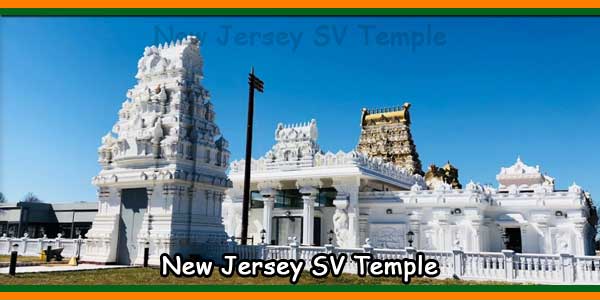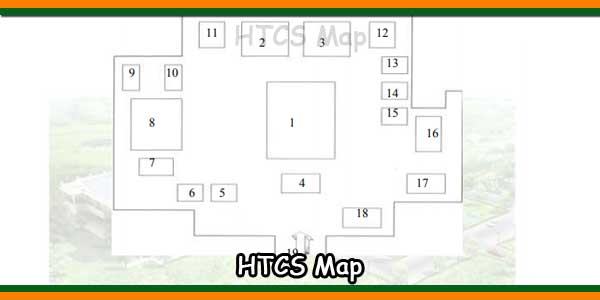New Jersey Sri Venkateswara Swamy Temple Hours:
Weekends, National Holidays and Festivals: 8:30 AM to 8:30 PM
Weekdays: 8:30 AM to 12:30 PM and 4:30 PM to 8:30 PM
Nitya Aaradhna: 9:30 AM to 10:00 AM and 6:00 PM to 6:30 PM
(Note: Please start from the Temple flag staff in front of the tall Temple tower.)
Namasthe (Namaskar)! This is the Indian traditional way of greeting an individual or a group.
Welcome to self-guided Temple tour.
A Temple or Devalaya is a place of worship. Deva means God and Alaya is House. Several smaller Temples or Sannidhanams are structured within the main Temple. A traditional Hindu Temple is built based on the Agamas, which are the Holy Scriptures on architecture. Agamas also provide guidelines for the conduct of worship (prayer). The Hindu Temple and Cultural Society of USA Inc. (HTCS) was
established in September of 1989. Our Temple was designed by Indian Temple Architects (Sthapati) according to ancient Indian Temple building codes and was inaugurated (Kumbabhishekam) in 1998.
You are going to enter one of the most Beautiful Hindu temples in North America. Now you are standing close to a tall brass cased wooden pillar. This is called the Dhwajasthambham or the flag staff of our Temple. Most Hindu Temples have a Dhwajasthambham in front. Temple worship starts from this point.
You may see worshippers touching this pillar. Some may go around this one to three times. Some men place their body flat on the ground in front of this pillar. Prostration on the floor is called Sasthanga Namaskara. Women also do similar prostration on the floor in a bent way without placing their whole body on the floor. This symbolizes complete surrender of ones ego in veneration of the Lord. These are traditional ways of offering one‟s respect to God. Some may place their palms and fingers of both the hands together, hold the hands close to the chest, and meditate on God. This is a very common way of offering respect to God or when you greet someone. When you go into the Temple, you will see more worshippers doing this.

From this point (Dhwajasthambham) you also notice an elevated walkway around the Temple. This is called the Prakaram. This is also a traditional part of Hindu Temples. Worshippers walk around the temple on the Prakaram (in the clockwise direction) and offer prayers to God. One can go around as many times as they wish. This process is called Pradhakshina.
Are you ready to enter Temple? In front of the Dhwajasthambham you see a tall Beautiful tower with plenty of art work. This is called the Rajagopuram of Temple. The Temple is designed and built following chola style of Temple architecture.
Please go up the wide steps that you see in front and go through the two tall doors (main entrance to the temple). You will notice the Temple office to your left and steps going down to your right. You can use these steps to go down and leave your shoes in the designated area. Some devotees leave their shoes outside the main entrance, when the weather permits. Visitors must remove their shoes before entering the Temple. Some also prefer to wash their feet and hands in the designated area in the Temple basement. When you return to the main floor, standing in front of the temple office facing inside, you will see two more doors, which are normally wide open during Temple worship hours.
As you walk in, you are entering the main prayer area. This point is indicated by an arrow in the floor plan shown in the last page. Devotees coming to our Temple can worship several Deities (Vigrahas)(different manifestations of God). However, Temple priests (who have learned Hindu agamas from religious schools in India) conduct all the religious services to the Deities. The worship includes giving sacred bath (abhishekam), decorating the Deity (Alankaram), chanting Deity‟s names / Praising the glory of the God (archana), offering food to the Deity (prasadam) and various other Hindu rites which are openly witnessed by all the devotees. After a Prayer session the priests transfer God‟s Blessings to the devotees through holy lights (harathi) and spoon full of holy water (theertham). In front of Venkateswara Sannidhanam, devotees also get direct Blessings from God‟s Feet when the Priests place a silver crown with two symbolic feet (shathari) on the devotee‟s head. Some prasadam (dry fruits) is also distributed to all the devotees.
Bhagavad-Gita (The sacred text of Hindus) Chapter 4, Verse 11 talks about worshiping the Lord in various forms of his manifestations. “In what so ever form, men worship me, in the same way do I full fill their desires”. Everyone follows my path.
In this temple one can see many Deities made up of granite and some are made up of panchalohas (five metals). A few of them are made up of marble. The granite vigrahas are permanently fixed in designated locations, they are called the „Moola vigrahas‟. The metallic vigrahas can be taken around within the Temple as well as outside. These are called „Utsavamurthys‟. The procession takes place by placing the Deities on top of the different vahanas (vehicle). Mooshika (Mouse) is the vehicle for Sri Maha Ganapati. Nandi(Bull) is for Siva-Parvati and Mayura (peacock) is for Sri Subrahmanya. Aadisesha (snake), and Garuda (Divine Bird) are the vahanas (vehicles) for Lord Vishnu. Gaja Vahana (Elephant) is Lord Rama‟s vehicle. Such processions are scheduled on religiously significant days.
Now, please move close to #1 in the floor plan, shown on the back.
You are now standing in front of Sri Venkateswara the presiding Deity of Temple. He is a manifestation of Lord Vishnu, the savior of mankind. You can also see the utsava murthys placed on a silver pedestal inside. Looking in the opposite direction you can see Garuda. Garuda is number four on the plan.
Now, please move closer to number 5.
Now you are standing closer to Sri Maha Ganapathi. He is the son of Siva and Parvati. He is the remover of obstacles. Devotees pray to Lord Ganesha before starting anything new, such as new house or new project.
Please walk to the area of the Vigrahas 6 through 10.
Number 8 is Siva Lingam. Siva Lingam is a universal form of Lord Siva. Siva is worshiped for safety and knowledge.
Ambika (Parvati), the Divine consort of Lord Siva is located in 6. Ambika (Parvati) is worshiped for auspiciousness.
Number 7 is Nandi (bull) the divine vehicle of Lord Siva-Parvati.
Please move closer to location 9 on the map. Now you see Sri Ayyappa. He is the son of Lord Siva and Mohini, who is an appearance of Lord Vishnu. Praying Ayyappa leads us to self control.
Sri Subrahmanya is located in number 10. He is the second son of Siva and Parvati. Valli and Devasena are His divine consorts. You can also see these three utsava murthys placed in a pedestal on top of a Silver Mayura (Peacock), the divine vehicle of Lord Subrahmanya, who is worshiped for health and children. Valli is on the left, Devasena in the right, and Subrahmanya in the center.
Now please move to Sri Satyanarayana Temple with his divine consort Rama Devi. Located by #11 on the map. Sri Satyanarayana is a manifestation of Lord Vishnu. Praying Lord Satyanarayana leads us to find the ultimate truth.
Temples located by #2 and #3 are next to Sri Satyanarayana Temple. Number 2 is Sridevi and 3 is Bhudevi. Sridevi and Bhudevi are the two consorts of Lord Venkateswara. Sridevi (Mahalakshmi) signifies wealth and glory, and Bhudevi represents mother earth and supports our existence.
Moving closer to number 12 on the map, you see Goddess Durga. She is the Divine mother of all the existence, and forgiver of all the sins.
Utsavamurthys of Lakshmi, Durga, and Saraswati are placed in location 13. Lakshmi is the goddess of wealth , Durga the goddess of cosmic energy. Saraswati is the goddess of knowledge.
Please move close to location 14 on the Temple floor plan. Lakshmi Narayana is situated in this location. You see Lord Vishnu and His Divine Consort here.
This takes you to The Radha Krishna Temple located in 15. You see Lord Krishna here with His devotee Radha. Lord Krishna is another incarnation of Lord Vishnu. Krishna worship leads us to Universal Love.
Please carry on with your Pradakshina to the Sri Rama Temple, which is number 16 on the map. Lord Rama, an incarnation of Lord Vishnu, with His wife Sita is seen to his right. His brother Lakshmana is on the left. Lord Rama‟s devotee is in far right of Lord Rama. He is called Anjaneya or Hanuman. There is a Temple for Hanuman Himself. Please move to number 17 of the floor plan. Worshiping Rama helps good family relations and character.
Here you see Sri Anjaneya, carrying a mountain in his hand. This is the sanjeeva parvatham that He brought from the Himalayas, which has reference in the Great Indian epic, Sri Ramayana. Hanuman worship leads us to attain strength and courage.
Going around Sri Anjaneya Temple, you can come to the Navagrahas. This is number 18 in the map. These are the nine planets, which, according to Hindu religion, have a significant influence on the life on earth. The Sun is in the center with Saturn behind and going in the clock-wise direction from Saturn are Ketu (the ascending planet), Jupiter, Mercury, Venus, Moon, Mars, and Rahu (the descending planet).
This concludes Temple tour. In addition to the religious services, HTCS also conducts cultural, educational, and community services. The Temple is open on all days for worship. On weekdays it is open from 8:30 AM to 11:30 AM and 4:30 PM to 8:30 PM. During weekends, National Holidays, and Festivals, it is open between 8:30 AM to 8:30 PM.
The Temple has a gift shop operated by the Temple volunteers. Gift shop offers a variety of items of religious importance for purchase by devotees.
It was a pleasure to offer you this guided tour. May The Lord Sri Venkateswara Bless you and your family.
Hindu Temple requests you to take home this message from Bhagavad-Gita,Chapter 12, Verse 13 and 14.
“Friendly and compassionate to all, and without any touch of hatred, devoid of possessiveness and arrogance, ever content and contemplated, alike in happiness and misery, self controlled and firm in conviction, dedicated to me with all his heart and all his soul, he who thus devoted to Me is dear to me”. Namaskar!

Sri Venkateswara Temple (HTCS)
1) Sri Venkateswara
2) Sridevi
3) Bhudevi
4) Garuda
5) Sri Maha Ganapati
6) Ambika
7) Nandi
8) Siva Lingam
9) Sri Ayyappa
10) Sri Subrahmanya
11) Sri Satyanarayana
12) Durga
13) Lakshmi/Durga/Saraswati
14) Lakshmi Narayana
15) Radha Krishna
16) Sri Rama
17) Sri Anjaneya
18) Navagraha
19) Dhwajastambham
New Jersey Sri Venkateswara Swamy Temple Address:
Hindu Temple & Cultural Society of USA, Inc.
Sri Venkateswara Temple (Balaji Mandir) & Community Center,
(Non-Profit Tax-Exempt Organization.),
1 Balaji Temple Drive Bridgewater,
New Jersey – 08807, USA.
Phone: (908) 725-4477
